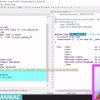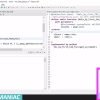This video is a continuation of a tutorial series on ABAP Managed Database Procedures (AMDP) in SAP. Here’s a summary of the key points:
- Handling Select Options in AMDP: The video discusses how to handle select options in AMDP. The presenter explains that in standard ABAP, select options are handled directly by the database interface, which converts the select options into a format that the database can understand. However, in AMDP, the SQLScript language does not support select options, so they need to be converted into a format that SQLScript can understand.
- Using the CL_SHDB_SELTAB Class: The presenter demonstrates how to use the CL_SHDB_SELTAB class to convert select options into a string that can be used in SQLScript. The class has a static method called COMBINE_SELTAB that takes all the select options and converts them into a string. This string can then be passed to the AMDP procedure or function as an input parameter.
- Creating an AMDP Method: The presenter shows how to create an AMDP method that handles select options. He explains that the method needs to take an internal table as an input parameter, which contains the select options. The method then uses the COMBINE_SELTAB method to convert the select options into a string, and uses this string in a SELECT statement to retrieve data from the database.
- Demonstration: The presenter demonstrates how to call the AMDP method from a program. He shows how to pass select options to the method and how to display the retrieved data. He also shows how to handle errors by using a TRY…CATCH block and how to view the error message.
- Other Important Points: The presenter discusses some important points about handling select options in AMDP. He explains that the select options need to be handled explicitly in AMDP, and that the client handling in AMDP is not implicit. He also emphasizes that the data should be filtered as early as possible to reduce the amount of data that needs to be processed.


















